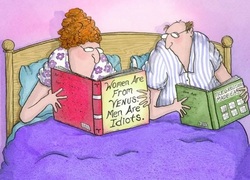 Both men and women enjoy nonfiction.
Both men and women enjoy nonfiction. There are, as I have long suspected, differences between men and women.
According the the National Endowment of the Arts, men are more likely to read nonfiction books than fiction, while the opposite holds true for women: 55% of women read fiction in 2012, and 48% read nonfiction.
The real news here is not that 7% more women read fiction than nonfiction, or that more women than men read fiction. It is the steady decline in the total fiction-reading population.
___________________
The waning literary leanings of American adults
Year Percentage of adults who read fiction
1982 56.40%
1992 54.20%
2002 46.60%
2008 50.20%
2012 46.90%
A ten point drop may not appear to be much, but in sheer numbers it represents a LOT of people. (Someone else will have to do the math, But given an adult population of roughly 230 million, I am sure it's more than, say, a hundred.)
____________________
The huge difference between what men and women read
MarketWatch, Published: Jan 29, 2015 3:25 p.m. ET
Most Americans don’t read fiction, but the residents of some U.S. states are far bigger bookworms than others.
The number of adults who read at least one novel, play or poem within the past 12 months fell to 47% in 2012 from 50% in 2008, according to a new survey of over 37,000 Americans, “A Decade of Arts Engagement,” by the National Endowment for the Arts, a government agency that promotes artistic excellence.
Fiction reading rose from 2002 to 2008, but has been dropping ever since — and is now back to 2002 levels. By comparison, 30 years ago 56% of Americans read fiction. The decline in fiction reading last year occurred mostly among white Americans, including women and men of various educational backgrounds; rates held steady among non-white and Hispanic groups, the report found.
Men are more likely to read nonfiction books than fiction, while the opposite holds true for women: 55% of women read fiction in 2012, and 48% read nonfiction, according to an update of a previous NEA report released in 2013. Young adults are more likely to read fiction than nonfiction books, whereas the oldest Americans (aged 75 and older) are more likely to read nonfiction books, the NEA found. Literary reading varied widely from state-to-state: It was 63% in Washington state, far above the national average, and 56% in Colorado, Rhode Island and Connecticut, but just 34% in Alabama, 36% in Virginia and 37% in Nevada.
Read more here...
 RSS Feed
RSS Feed